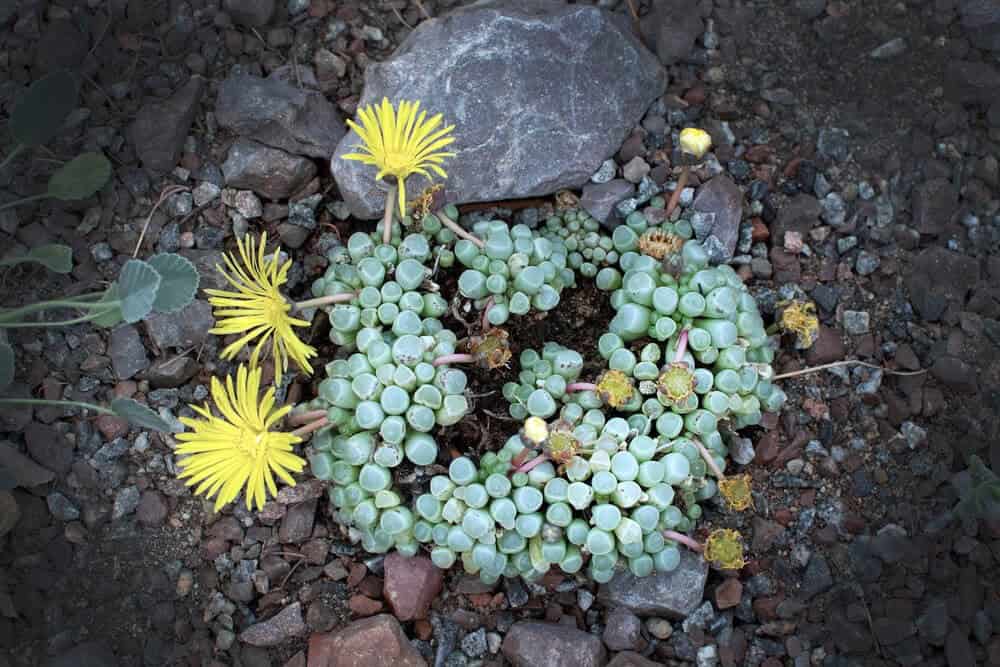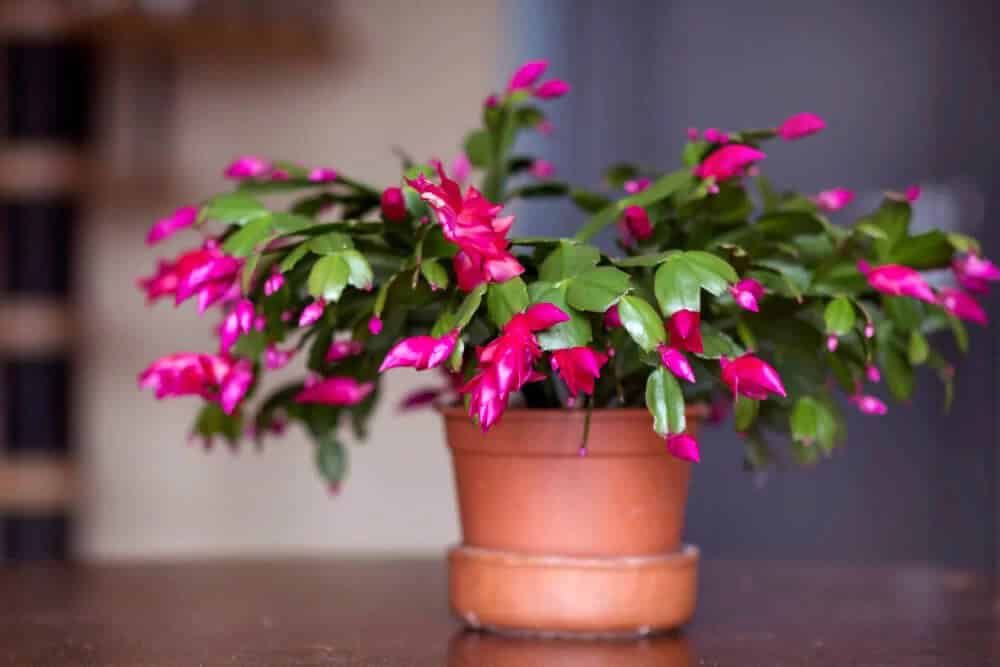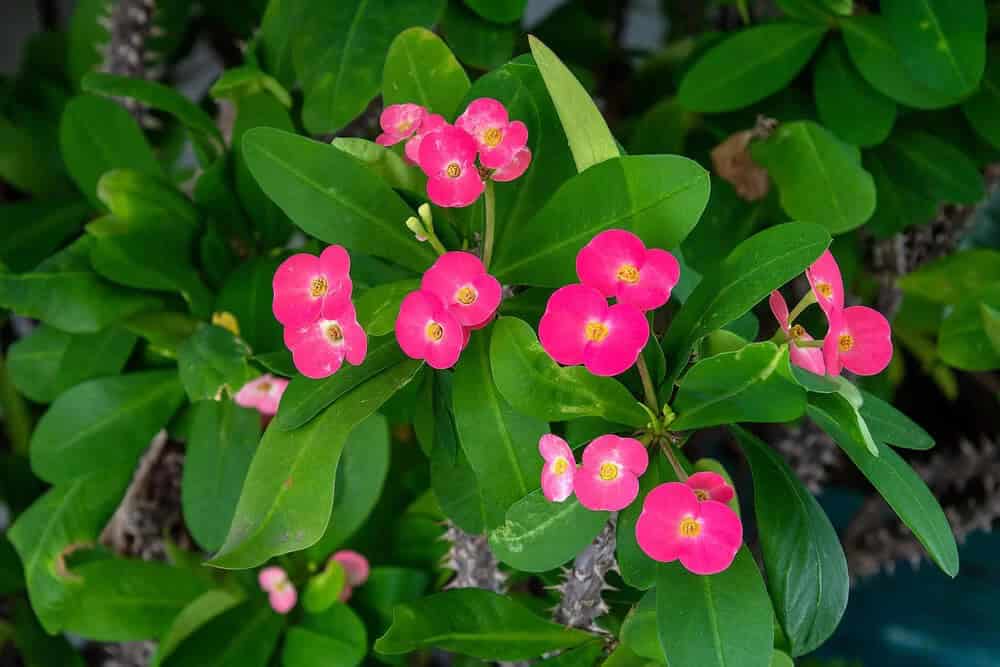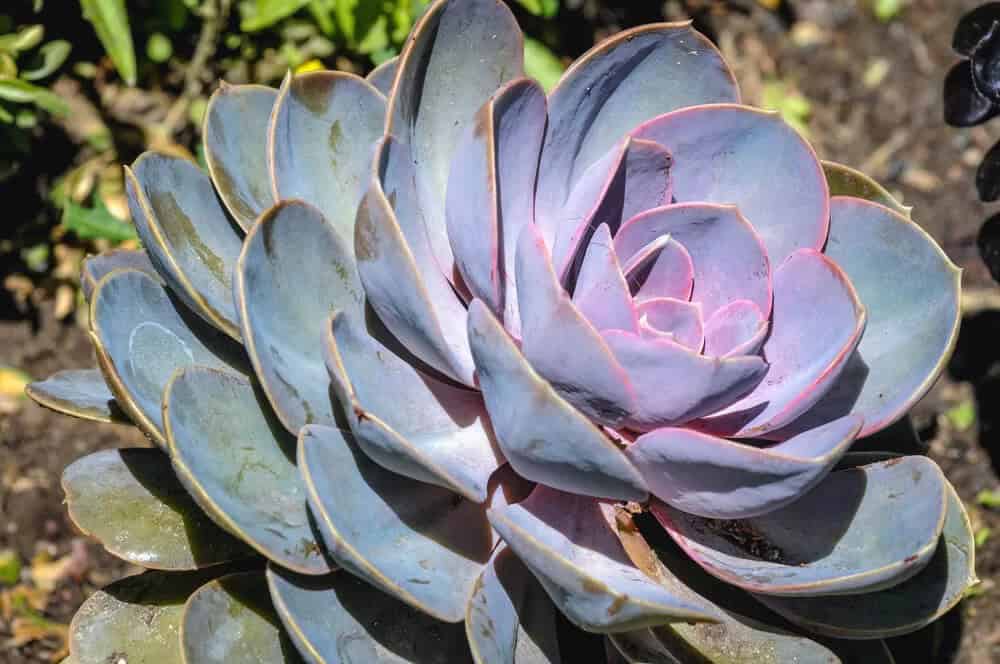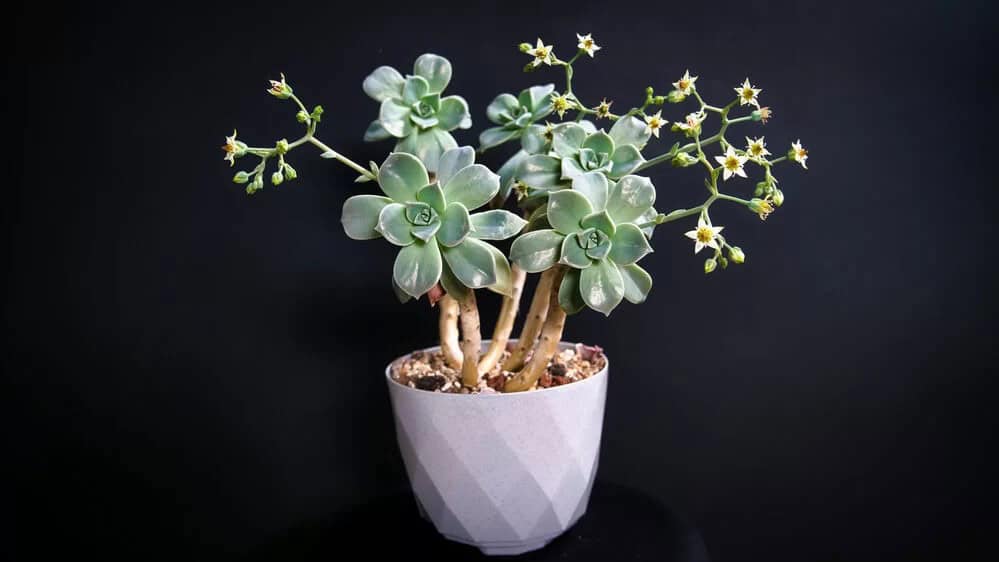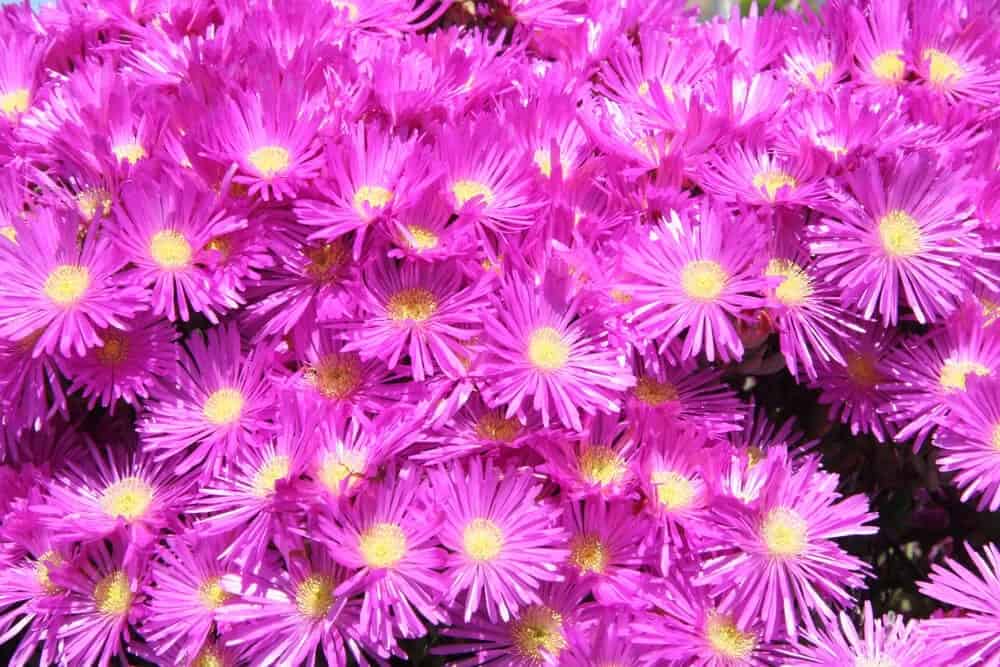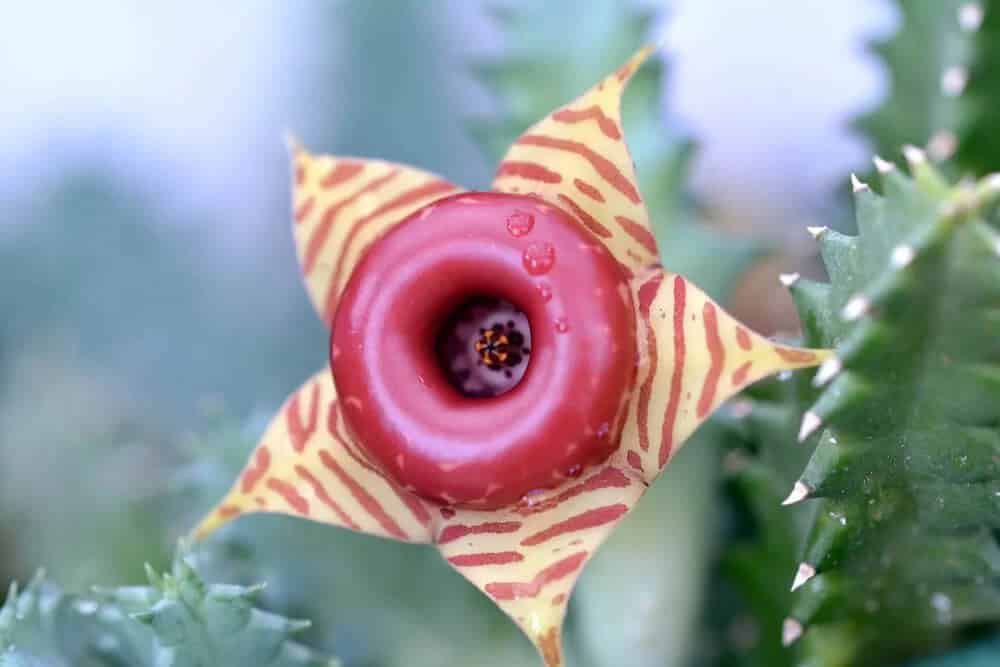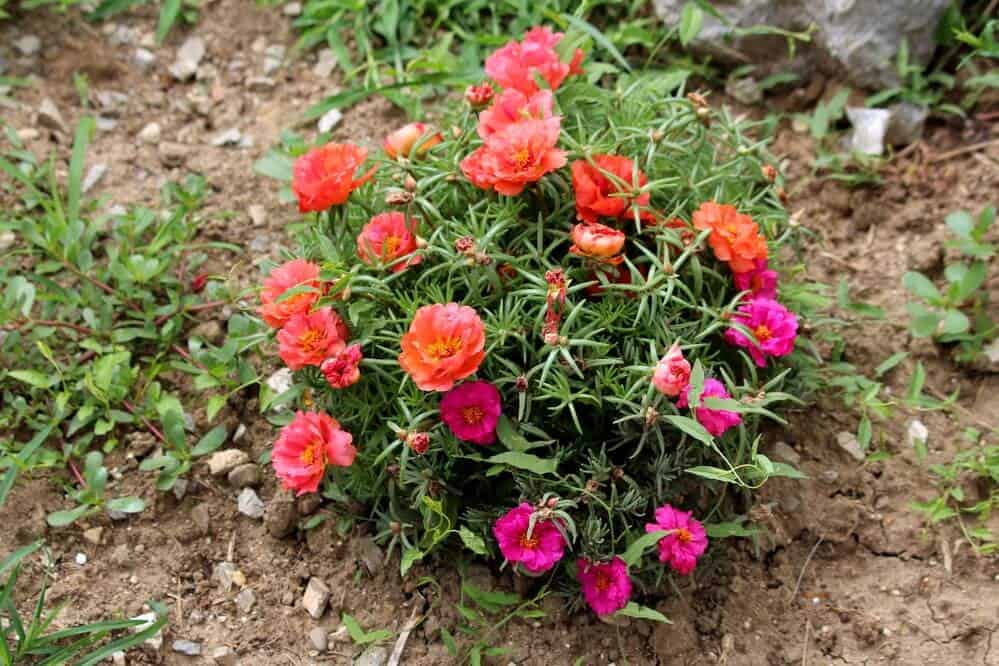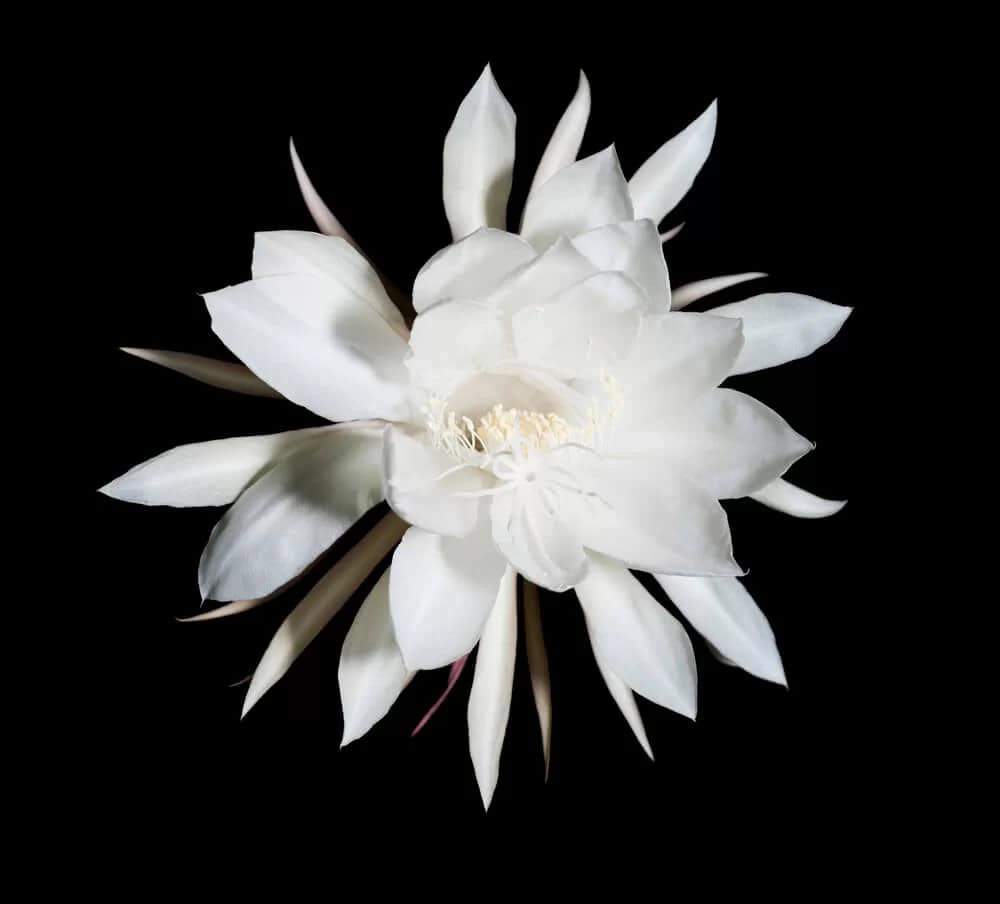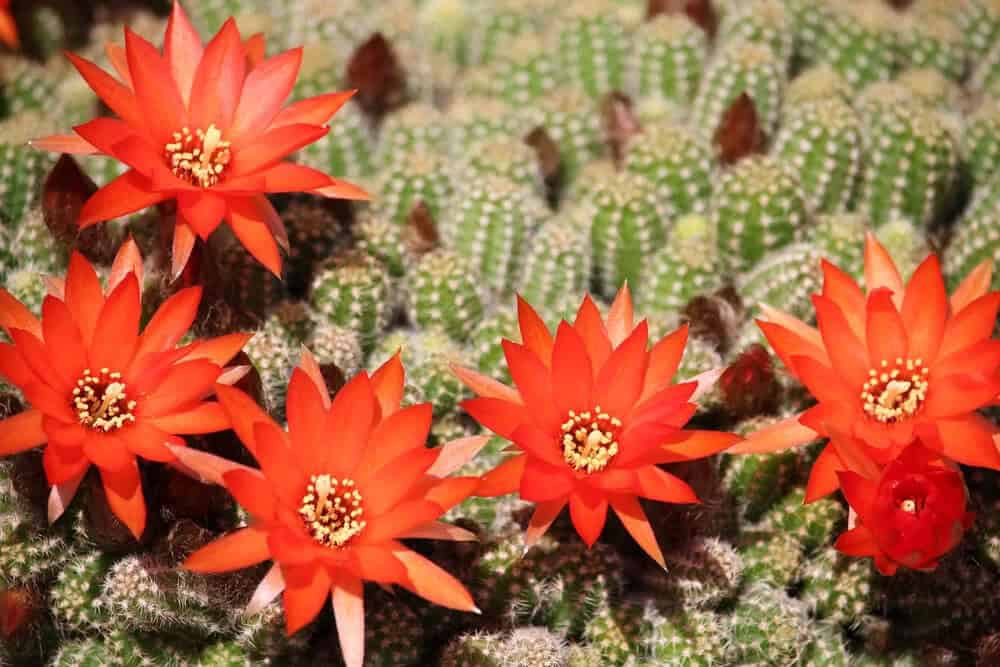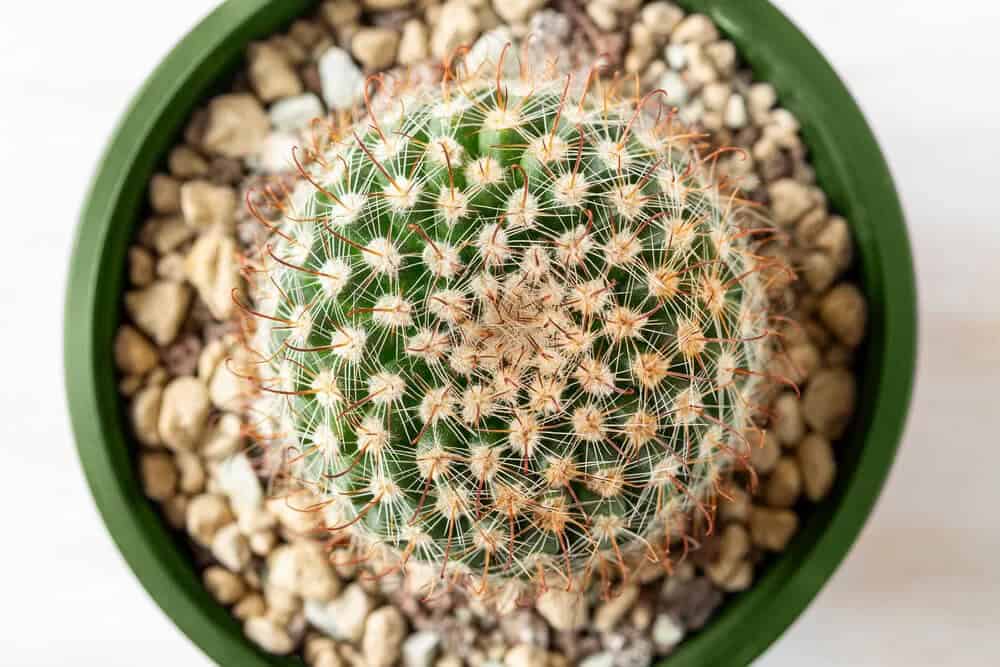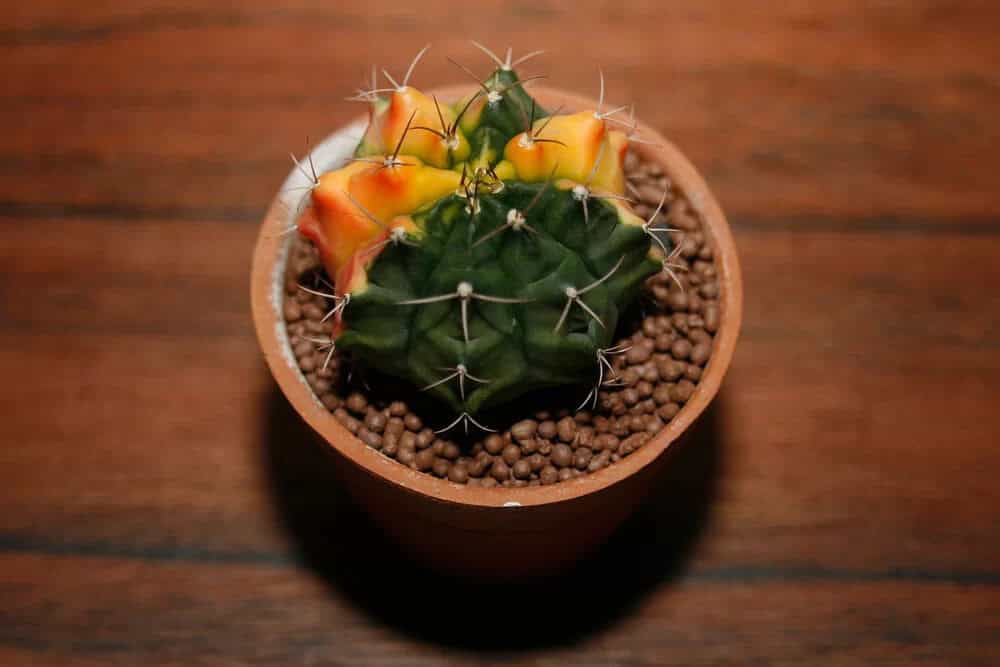Succulent enthusiasts are no strangers to their unique and fascinating leaves, which not only showcase a stunning array of shapes and colors but also serve a vital purpose. By storing significant amounts of water within their fleshy leaves, succulents have adapted to thrive in arid environments, making them an ideal choice for indoor gardeners seeking low-maintenance options.
While many people are aware of this remarkable trait, they often overlook the fact that succulents can also produce breathtaking flowers. This article aims to address this oversight by highlighting the top 19 low-maintenance flowering succulents, showcasing not only their captivating foliage but also their impressive floral displays.
Key Takeaways
While diving into the world of flowering succulents, it’s essential to grasp some fundamental concepts about these fascinating plants. Beyond understanding each individual species, there are several broader points that can help you appreciate the wonders of succulent cultivation. Here are five key takeaways that will become apparent as you explore this list: Succulents are an ideal choice for indoor gardeners seeking low-maintenance beauty.
Many succulents require minimal upkeep to thrive, making them perfect for busy or novice plant enthusiasts. You might be surprised to discover the sheer variety of flowering succulents, with blooms ranging from stunning to simply astonishing. However, some species can only be coaxed into bloom by growing outdoors or near the end of their lifespan. The succulent family is incredibly diverse, comprising numerous species and genera that offer a wealth of options for plant enthusiasts.
19 Stand-Out Low-Maintenance Flowering Succulents that Grow with Ease
Aloe vera (Aloe vera)
The succulent plant world would be incomplete without mentioning aloe vera, an iconic species that’s equally revered for its ornamental value and touted benefits for human health. The standout feature of this plant is its foliage, characterized by long, triangular leaves that ooze a liquid substance rich in holistic properties.
For most of its life cycle, the foliage is the dominant above-ground presence, but as aloe vera reaches the end of its lifespan, it’s transformed into a showy display of large, spiky flowers with a striking pinkish-orange hue.
Baby Toes (Fenestraria rhopalophylla)
The Fenestraria rhopalophylla succulent plant is often referred to as ‘baby toes’ due to its unique physical appearance. The plant’s fleshy vertical foliage takes on a cylindrical shape, closely resembling a set of baby’s toes. This distinctive feature is further accentuated by the plant’s ability to produce large daisy-like flowers with white petals and yellow centers, or occasionally entirely yellow blooms.
Not only are these visual attractions notable, but ‘baby toes’ also proves to be surprisingly low-maintenance. To keep this succulent thriving, simply provide it with full sun exposure, and it will thrive despite minimal care.
Christmas Cactus (Schlumbergera bridgesii)
Christmas cactus, a flowering succulent renowned for its vibrant blooms around the holiday season, boasts an effortless growth habit. Its fleshy foliage is characterized by a unique chain-like appearance that arches and weeps over containers, creating a dramatic display. As the plant reaches its blooming phase, the flowers emerge at the tips of the leaves, showcasing a kaleidoscope of colors including pink, white, and purple.
This stunning color palette makes Christmas cactus an ideal choice for adding festive flair to your space during the latter part of the year.
Crown of Thorns (Euphorbia milii)
What sets the crown of thorns plant apart from its succulent counterparts is its unique morphology. One distinctive feature is the leaves themselves, which are significantly thinner and less substantial than those found on other types of succulents. The stems of this plant also deserve attention, as they’re thick, spiky, and give rise to the plant’s common name. While these stems may not initially appear inviting, the flowers that adorn them are a different story altogether.
These small, pink blooms cluster together in a pleasant spherical shape, offering a burst of colour that adds visual interest to an already striking plant.
Desert Rose (Adenium obesum)
As you might guess from its name, the desert rose is a succulent species renowned for its striking bloom characteristics. And indeed, it delivers on that promise. The desert rose produces large, rose-like flowers adorned with delicate petals that can range in color from vibrant pink to deeper magenta and white hues. But what truly sets this plant apart is its unique growth habit. Unlike many other plants, the desert rose develops woody branches that arise from a sturdy, irregular trunk.
When grown outdoors in its native region or similar conditions, the desert rose can reach impressive sizes. However, even when cultivated indoors, it still maintains its signature charm and beauty.
Echeveria (Echeveria)
Echeveria plants are undoubtedly one of the most iconic succulent species, widely cultivated in homes worldwide due to their ease of growth in containers. Their characteristic thick, rounded leaves grow in a radial pattern, featuring a striking green-blue hue that can subtly shift towards magenta undertones. Notably, Echeveria plants only bloom once during their lifetime.
While this may be the case, many people argue that the intricate pattern and shape of the foliage itself resembles a flower, making it a perpetual delight regardless of the season. With proper care, you can expect to marvel at the unique beauty of these plants throughout their entire life cycle.
Flaming Katy (Kalanchoe blossfeldiana)
The humble Flaming Katy succulent is a familiar sight in many gardens, yet despite its ubiquity, it’s often overlooked for its more exotic cousins. However, this charming bloomer is certainly worth getting to know. Unlike some flowering succulents that only bloom once at the end of their life cycle, Flaming Katy is a repeat offender, producing clusters of small but vibrant flowers throughout its lifetime.
These tiny blooms typically come in shades of red, orange, or yellow, earning the plant its fiery moniker. It’s this prolific blooming habit that sets Flaming Katy apart from other succulent varieties, making it a delightful addition to any garden or indoor space.
Ghost Plant (Graptopetalum paraguayense)
Unlike its intimidating name, the Ghost plant is a breeze to care for, eliminating any need for anxiety or apprehension. Its care requirements are remarkably straightforward, making it an ideal choice for even novice gardeners. The plant’s foliage bears a striking resemblance to that of the Echeveria, yet its growth habit is distinctly different. Instead of producing upright stems like its Echeveria counterpart, the Ghost plant features light tan stalks, upon which its leaves grow.
Additionally, the plant develops irregular stems that emerge at seemingly random angles, supporting small, off-white, star-shaped flowers.
Ice Plant (Aizoaceae)
While at first glance, the flowers of an ice plant may appear strikingly similar to those of an aster plant, it’s essential to note that these species are not closely related. Despite this, both plants possess unique qualities that make them valuable additions to any garden. The ice plant’s long, purple petals boast a remarkable sheen, allowing them to interact harmoniously with natural light.
Furthermore, its foliage is characterized by an unusual shape reminiscent of bean pods, adding an extra layer of visual interest.
Jade Plant (Crassula ovata)
Despite its nickname ‘money plant’, the jade plant’s ability to bring good fortune and prosperity is not what makes it a great addition to your home. In fact, whether you believe in the plant’s mystical properties or not, there are plenty of practical reasons to cultivate this low-maintenance flowering succulent. The jade plant boasts stunning, rounded leaves with a lustrous sheen that can add a touch of elegance to any room.
And while it’s rare for the plant to bloom with small white or pink flowers, even those who don’t get to witness this treat will appreciate the jade plant for its many other charms.
Lifesaver Plant (Huernia zebrina)
The lifesaver plant’s floral display is nothing short of astonishing. This low-maintenance succulent produces blooms that are so extraordinary, you’ll struggle to believe they’re real. Each flower features a striking central hub, reminiscent of a miniature donut, with a deep red hue. The crowning glory, however, are the five petal-like structures surrounding this focal point, boasting an intriguing zebra-like pattern of interlocking light yellow and red stripes.
To truly appreciate the mesmerizing beauty of these flowers, there’s no substitute for growing one yourself.
Moss-Rose Purslane (Portulaca grandiflora)
While the previous succulent on the list boasted an extraordinary flower shape and color combination, the moss-rose purslane presents a more understated yet still captivating display. Its small, bright yellow center is surrounded by five petals that can surprise with their versatility in terms of color. On the same plant, you might find flowers in hues ranging from sunny yellow to deep purple, fiery red to crisp white, each one showcasing its unique charm.
Queen of the Night (Epiphyllum oxypetalum)
While many flowers on this list have certainly been intriguing, the queen of the night succulent stands out for its unique combination of appearance and blooming habits. What makes this flower truly fascinating is not just its striking shape and pure white color, but also the peculiar timing of its bloom cycles.
Unlike most flowers that burst forth during the day, the queen of the night succulent opens its blooms only under the cover of darkness, providing a mesmerizing spectacle for those who observe it in the hours just before dawn. To truly appreciate this flower’s beauty, however, one must also provide it with indirect light during the daytime, allowing it to thrive and prepare for its nocturnal display.
Old Lady Cactus (Mammillaria hahniana)
The old lady cactus, despite its unassuming name, has the power to impress with its unique texture and vibrant blooms. This compact, rounded plant boasts an abundance of soft, white feathery appendages that add a tactile element to your indoor space. Its crowning glory is the stunning magenta flowers that burst forth at the top of the plant, providing a striking contrast to the rest of its subtle appearance.
Orchid Cactus (Disocactus ackermannii)
For those who adore succulents with show-stopping blooms, the orchid cactus is an ideal choice. Its flowers can reach astonishing sizes – sometimes exceeding half a foot in diameter – showcasing vibrant colors that are sure to captivate. While light pink hues are common, you may also stumble upon yellow, orange, or white varieties, offering a delightful surprise. To keep your orchid cactus thriving, simply ensure it receives indirect light and moderate fertilization.
With proper care, this stunning succulent will be the envy of any plant enthusiast.
Paddle Plant (Kalanchoe luciae)
The Paddle Plant’s unique appearance is characterized by its elongated leaves, which resemble paddles and can grow up to a few inches in length. The leaves are arranged around a central stem, forming a pyramidal shape as they increase in size from the base of the plant towards the top. This distinctive silhouette is further enhanced by the occasional cluster of small, reddish-orange flowers that bloom at the center of the plant.
Peanut Cactus (Echinopsis chamaecereus)
The peanut cactus stands out for its unique ability to offer multiple visual attractions simultaneously. Its small, rounded foliage boasts an undeniable charm, setting the stage for a striking contrast with the plant’s flowers. These elegant blooms feature oblong petals with a vibrant red hue and a bright yellow center, exuding refinement and sophistication.
To promote healthy growth, cultivate this species in well-draining, acidic soil that is loose and fertile, allowing it to reach a height of a few inches.
Pin Cushion Cactus (Mammillaria crinita)
While succulent plants can be incredibly diverse, this entry on our list has a notable connection to another featured species. The pincushion cactus and old lady cactus share a common genus, characterized by their rounded shapes and distinctive feathery textures. Furthermore, the low-maintenance flowering succulents in question exhibit similar floral arrangements. On the pincushion cactus, vibrant purple blooms encircle the plant’s summit, creating a striking crown-like effect.
Ruby Ball Cactus (Gymnocalycium mihanovichii)
The moon cactus, also known as the ruby ball cactus, may be one of the most striking entries on our list of low-maintenance flowering succulents. Its distinctive appearance features a single, rigid green stem topped with a colorful round structure that can display an array of hues, including vibrant reds and yellows, as well as a deep, nearly black shade. The unique combination of its colors and shape has earned it several descriptive common names.
While this plant’s visual appeal is certainly notable, it’s also incredibly easy to care for. In some cases, it can even thrive in shadier conditions than other succulent options.
Frequently Asked Questions About Low-Maintenance Flowering Succulents
Is There a Succulent that Blooms?
While it’s true that low-maintenance flowering succulents offer an impressive display of blooms, this plant group is often more celebrated for its stunning foliage. However, what may come as a surprise is that many of these succulent varieties require specific conditions to produce their flowers. In fact, some flowering succulents will only bloom when grown outdoors in ideal conditions, whereas they may not flower at all when living indoors.
This highlights the importance of considering the right environment for your succulents to truly thrive and showcase their floral beauty.
Which Succulents Grow Like Flowers?
While many succulents produce beautiful blooms, some species boast growth habits that mimic common flower shapes. A prime example is the Echeveria succulent, which not only produces flowers but also boasts foliage that takes on a floral appearance. The leaves of this plant arrange themselves in a radial pattern, evoking the petals of a rose or daisy flower. This arrangement lends the leaves a flower-like quality, even though they’re not technically blooms.
Are Succulents Low Maintenance?
One of the biggest advantages of growing succulents is their remarkably low maintenance requirements compared to other plants. This is largely due to their unique ability to thrive in dry environments by storing water in their thick, fleshy leaves. As a result, succulents are extremely well-suited for indoor cultivation, where dry air and limited moisture are the norm.
In most cases, providing your succulent with adequate sunlight and soil that drains efficiently is all it needs to stay healthy and vibrant, freeing you from the need for constant attention and care.
What Succulent Has Lots of Little Flowers?
While some succulents may boast a single show-stopping bloom, others offer a more exuberant display of smaller yet still delightful flowers. Take the Flaming Katy plant, for instance, which erupts with numerous petite blooms. Similarly, the Crown of Thorns succulent treats onlookers to a profusion of diminutive yet charming flowers. While these and other varieties do exist, it’s worth noting that many flowering succulents still tend to feature medium to large-sized blooms.
What is the Prettiest Succulent Plant?
While it’s challenging to pinpoint the most visually stunning succulent, this ambiguity can be attributed to the sheer diversity of species and the inherently subjective nature of aesthetic appeal. The upside is that there are countless varieties to explore, each boasting a distinct appearance that will surely pique your interest.
Ultimately, discovering your own personal favorite among these stunning plants comes down to taking the time to get familiar with their diverse forms, shapes, and hues.
What Succulent Dies After Flowering?
While succulent flowers are undoubtedly stunning, it’s crucial to recognize that not all succulents bloom again after their initial flower period. This is due to the plant’s inherent biology, rather than poor care. For instance, Echeveria succulents typically die off after a single blooming cycle, and they’re not alone – several other species, including agave and living stone, exhibit similar behavior. It’s essential to understand that this isn’t uncommon among certain types of succulents.
Despite this, many gardeners remain unfamiliar with these unique plants, even seasoned enthusiasts. As such, we aim to bridge the knowledge gap by addressing frequently asked questions about low-maintenance flowering succulents.
19 Eye-Grabbing Low-Maintenance Flowering Succulents that will Blow You Away
While succulents’ stunning foliage and low maintenance needs make them an excellent choice for indoor gardening, their flowering capabilities are often overlooked. Many succulent species boast vibrant, brightly colored blooms that add to their visual appeal. If you’re looking for a succulent that can thrive indoors and provide both attractive leaves and flowers, our list above is a reliable starting point.
Once you’ve selected your preferred species, you’ll find it easy to keep your succulent happy and healthy in your home.

